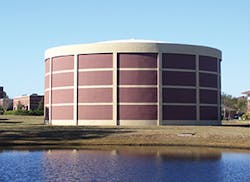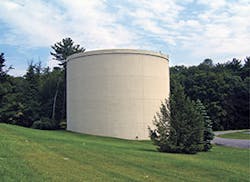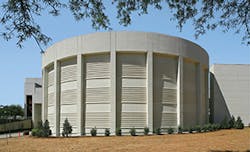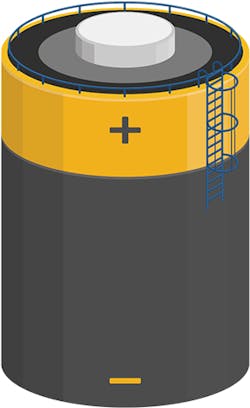For more than 25 years, retailer JCPenney has relied on ice-based energy storage from CALMAC to save hundreds of thousands of dollars in energy costs. In 2015 alone, the retailer’s headquarters in Plano, TX, reduced its annual energy bill by more than $100,000.
In an era in which brick-and-mortar retailers are struggling with their bottom-line profits, the importance of reducing costs has only grown. This is why the energy savings that JCPenney has realized from ice-based energy storage is so critical.
And JCPenney is hardly alone. The owners of commercial buildings, industrial facilities, schools, hospitals, resorts, and government facilities are increasingly turning to thermal energy storage to help reduce the amount of power they consume during the most expensive peak hours of the day. Often, these building owners turn to chilled-water or ice-based storage as their preferred thermal energy storage method.
A 2.7 MG precast, prestressed, wirewound concrete tank on the state capital campus in downtown Raleigh, NC.
SAVING MORE THAN PENNIES
JCPenney’s example is a good one. CALMAC’s storage system has been in place at the company’s 1.8-million-square-foot headquarters for more than 25 years. The system is one of the largest in the world, producing and storing nearly 4 megawatts of cooling power, or 2.4 million pounds of ice each night.
JCPenney has been receiving a financial benefit from the ice-based energy storage since its installation in 1991. But in recent years, the importance of the energy-storage system has only grown. That’s because the public utility serving JCPenney now charges what is known as a ratcheted-demand charge in addition to a coincident peak charge. Both charges account for a large portion of the monthly utility bill for the headquarters building.
Under ratcheted-demand pricing, the month with the highest energy usage sets the annual peak demand charge. As an example, in 2013, the annual peak demand charge was set in August at $37,479. The charge is then ratcheted at 80%, meaning that for the 11 months after August, JCPenney paid a demand charge of $29,983.
CALMAC’s ice-based storage system helps JCPenney avoid higher energy bills, even with this change. The system creates ice in the evening, storing it in tanks. This is important because demand for power is the lowest, and cheapest, at night. The next day, the ice is used to cool the building. This allows JCPenney to cool its headquarters during the heat of the day without incurring the peak charges levied during this period.
“When the tanks were originally installed, the utility pricing was less complicated,” says Kyle Wilkes, energy and engineering director for construction services at JCPenney. “Now, with ratcheted rates and the programs available to us, we have a much more strategic plan for the ice tanks to target demand charges.”
Mark MacCracken, chief executive officer of CALMAC, says that JCPenney is among a growing number of commercial clients that understand just how important an economic tool energy storage can be. As of 2015, about 200 building owners and users in Texas alone were using the company’s IceBank energy storage tanks, MacCracken says. He explains that once demand charges are included in the equation, the price of energy is about 50% cheaper in the evening than it is during the day.
“This clearly demonstrates the value of energy storage,” says MacCracken.
SHIFTING TO OFF-PEAK
Guy Frankenfield, energy division manager with DN Tanks, said that the demand for and interest in thermal energy storage tanks is on the rise. That’s because these tanks are a key tool to allow building owners to shift a chunk of their energy production from the most expensive hours of the day to the least expensive, resulting in a significant reduction in their energy costs.
As an example, building owners can choose to run their cooling equipment more heavily in the evening hours, storing cold water in their facilities’ thermal energy storage tanks. During the day, when the energy rates increase or the public power grid becomes stressed, owners can shut off their cold-water generating equipment, saving on energy costs. They can also use the cold water in the tank to provide cooling for their buildings or processes.
“That’s how the electric load is shifted,” says Frankenfield. “That’s how these tanks act as virtual batteries.”
But these energy savings, however important, are just one example of the benefits that building owners receive from thermal energy storage.
Say a college or healthcare provider wants to expand its campus by adding a new building or increasing the size of an existing facility. This usually requires additional cooling. Instead of adding more mechanical refrigeration equipment to handle these added cooling needs, the university or hospital system can add a thermal energy storage tank.
These tanks require little to no maintenance. Again, the university or medical provider can simply store cold water at night and then use it as additional cooling capacity for the now expanded campus.
“We see that a lot on college campuses,” says Frankenfield. “The university is adding another building for dormitories or academics. A thermal energy storage tank is a much lower first cost than is adding additional cooling equipment. It also saves energy every year.”
Finally, thermal energy storage tanks can be used as backup systems, Frankenfield says. These tanks, for instance, might be installed at mission-critical data centers, facilities that can’t be without cooling for any period of time. A data center’s servers might be heating up. So the center has a storage tank in reserve to provide backup in case its chiller equipment goes offline. The data center can then switch to the cold water stored in the tank to make sure that it never goes offline.
“Data is preserved and they don’t have loss of connectivity to the grid,” Frankenfield said. “That is becoming another important benefit of thermal energy storage.”
Alamo Colleges in 2012 embraced the concept of thermal energy storage. That’s when the college contracted with Trane to provide a thermal energy storage system for its Northeast Lakeview College campus. Trane chose DN Tanks to provide a 1 million-gallon tank for the project.
A 3.0 MG energy storage tank designed to store
26,200 ton-hours of cooling capacity at a maximum chilled water flow rate of 8,300 gallons per minute
The goal was a simple one: The college wanted to save energy costs each year at Northeast Lakeview College in San Antonio.
The thermal energy storage system shifted the electric load of the chillers and their cooling equipment from peak periods during the day to off-peak periods at night. The system includes a stratified chilled water tank with 9,380 ton-hours of useable thermal energy storage capacity.
The central chilled water system now provides the cooling for the 370,000-square-foot college campus with more than 5,500 students.
The system shifts about 600 kilowatts from on-peak periods to off-peak hours. John Strybos, associate vice chancellor at Alamo Colleges, said that the system will save the college more than $140,000 in energy costs every year. The tank also provides added flexibility for the college’s maintenance staffers. They can now take the college’s physical plant down for several hours, if needed, to perform either emergency or routine services without worrying about interrupting the chilled water cooling supply to the campus.
DN Tanks says, too, that the tank at the college is a sturdy one. The company said that this thermal energy storage tank will provide decades of service.
Health in Danville, PA, is estimated to save the
center $85,000 annually in energy costs.
MAKING A DIFFERENCE IN FLORIDA
Chilled water storage has also benefited the University of Central Florida in Orlando. The university has installed 8,000 tons of high-efficiency electric motor-driven chillers since 2009. This means that chilled-water production capacity at the main campus’ central energy plants stood at 17,000 refrigerated tons as of early 2016.
The campus’ utility plants, combined with the university’s absorption chiller on campus, produce and deliver more than 36 million ton-hours of cooling each year to the campus’ facilities.
The university says that 73% of the main campus’ square footage is served by the district cooling loop. The remaining square footage is supported by stand-alone chilled-water systems and direct expansion and ground-source heat pumps.
To boost its energy efficiency even further, the university also installed a thermal energy storage tank in October of 2010. The thermal energy storage tank shifts two megawatts of load from peak to off-peak hours. This reduces about 40% of the peak demand for cooling, equaling a savings of about $320,000 every year.
The best news is that these are not isolated examples. Building owners across the country have embraced thermal energy storage tanks as an effective tool to reduce their yearly energy costs. The makers of these tanks say that this trend isn’t about to slow anytime soon. After all, building owners are increasingly focused on their bottom-line costs. Reducing how much they spend on energy costs can significantly increase their yearly savings.
Cameron Wise, regional manager of thermal energy storage and biofuels for DN Tanks, says that a growing number of government agencies, municipalities, and private industry clients are investigating and installing these tanks. Automobile manufacturers are especially interested in thermal energy storage today, Wise says.
“There are many different types of users who are investing in thermal energy storage,” says Wise. “We do get a lot of college campuses. But the demand for tanks is not limited to colleges. Because of the cost savings, because you can use these tanks as backup systems, and because they make it easier for facilities to expand their size, we are seeing interest in thermal energy storage from a wider range of end-users.”
Another growing area for thermal energy storage? Natural gas power plants.
Frankenfield says that natural gas power plants, which are becoming more common today than coal or nuclear plants, rely heavily on combustion turbines to generate their electricity. These plants bring in air, which they ignite, creating the combustion that drives a turbine which generates their power.
When it is hot in the middle of the day, though, the power output drops off from these turbines. The air becomes less dense, resulting in less mass airflow through the turbine. To increase the power output in the middle of the day, natural gas plants turn to inlet cooling systems, which typically operate like a chilled water system that provides inlet cooling and increases the mass flow through the turbine. That, in turn, increases the power.
The owners of natural gas plants can also add a thermal energy storage tank to these inlet cooling systems. In the middle of the day, when the plants need the most power, they don’t have to run a chiller or cooling equipment. They can just move the water from the tank through the piping in the coils to cool that inlet air.
“That reduces the electric load of the chiller plant during that peak period,” Frankenfield says. “This is a market that is maybe 10 years old at the most. It’s a new market for us.”
A BOON TO THE RESORTS BUSINESS
The users of thermal energy storage aren’t just college campuses and industrial users, of course. These tanks can save a wide range of users plenty in energy costs.
Consider the hotel industry. CALMAC, for example, has installed a thermal energy storage system in the Pacific Palms Resort in the community of Industry, California. The system allows the hotel to reduce its energy bills through permanent load shifting, better known as PLS. The storage system shifts demand for energy from peak periods to nighttime hours.
This resort uses CALMAC’s IceBank thermal energy storage to achieve this. The Pacific Palms Resort saves more than $300,000 in energy costs thanks in large part to this energy storage system, CALMAC says.
The resort is being proactive in embracing PLS and thermal energy storage. Energy costs are a big expense for a resort. By tackling these costs, the resort can significantly reduce its bottom-line expenses. Hospitality Net reported that the cost of electricity for hospitality facilities has been on the rise recently, jumping by 4.6% during 2014 alone.
Hotels and other end-users might also receive financial payouts from their home states for investing in thermal energy storage. That’s because several states have launched demand response plans that provide financial incentives for users that limit their energy consumption during periods of peak energy demand.
Hotels and resorts consume large amounts of electricity. So they stand to especially benefit from investing in thermal energy storage systems that allow them to consume more of their energy during off-peak hours.
Schools, though, do remain an important user of thermal energy storage. That’s because thermal energy storage not only reduces energy bills; it is also friendly to the environment because they last so long and are mostly recyclable.
The lab relies on a microgrid project that incorporates various forms of energy storage and a multi-physics approach to optimize the use of onsite sources of renewable energy. CALMAC’s ice-based energy storage system now provides this microgrid with a way to use solar and wind power to store cooling.
MacCracken said that fossil fuels have one big advantage over renewable energy: A barrel of oil or a chunk of coal is a form of stored energy that can be released at any time. Solar and wind, though, are forms of pure energy. If these renewables are not paired with some sort of energy storage system, they can be easily wasted.
That’s where energy storage comes in. It allows users such as the Naval Postgraduate School to store these forms of pure energy that also happen to be friendlier to the environment.
Energy storage is a key, too, for microgrids. These microgrids can either connect to the public power grid or work independently from it in what is known as “island mode.”
The naval school’s microgrid creates electricity through onsite photovoltaic panels and wind turbines. This energy is either used as it is generated or stored for later use.
Officials with the school laboratory say that this approach has not only resulted in a microgrid that is efficient, but one that results in lower energy bills each year.
“Applying the multi-physics approach to our microgrid project, over the traditional microgrid approach, allowed for the use of fewer renewable energy sources to meet demand, reducing size, costs, and the amount of unused energy,” says Dr. Anthony Gannon, assistant professor with the Mechanical and Aerospace Engineering Department at the Naval Postgraduate School.
“Using thermal energy storage allowed for the project to greatly reduce its costs and improve efficiency by storing the energy in the form that it would be ultimately used in. Based on the project’s operation, we feel like this design could easily be scaled-up for larger applications.”
An ice-based thermal energy storage system comes with other benefits, too. Because it relies on the phase change of water between solid form and liquid, the ice-bank technology is not susceptible to the negative effects of cycling and can instead completely discharge. Because of this, the lifespan of the ice-based storage tanks can exceed 25 years.
A BASELINE DIFFERENCE
“It’s all about the difference between day and night power,” says MacCracken. “There is a big difference between energy costs during the day and costs during the night. It’s usually about 50% more expensive during the day.”
There are other cities where the price differential is even higher. In New York City, for example, MacCracken says that the cost differential between energy during peak daytime hours and during off-peak evening hours is approximately 70%.
The problem? This cost difference is usually ignored when facilities are designed, MacCracken says.
This is a serious flaw. As MacCracken says, there is only one form of energy that has remained priced at a consistent level during the last four decades: off-peak electricity.
“That has stayed consistently low,” says MacCracken. “It’s a supply and demand thing. Natural gas has gone high and then came back down. Coal has fluctuated often during the last four decades. Peak electricity has done the same. But off-peak electricity always remains the same. That’s why it’s so important for building owners to tap into this form of electricity, which thermal energy storage allows them to do.”
MacCracken recommends that companies consider the savings of off-peak energy when designing their facilities and to include plans for thermal energy storage.
“If you’re going to be there for the next 40 or 50 years, you should consider what has consistently been the least expensive energy,” says MacCracken. “It’s been off-peak energy. That is important. Why wouldn’t you want to take advantage of the cheapest and most consistently priced form of energy for the future?”
MacCracken compares it to buying gas for a car. If a gas station sold gas for $2.50 a gallon during the day but only for 90 cents a gallon at night, when would you buy it? During the evening, of course.
“You wouldn’t have to put any thought into making that decision,” says MacCracken. “But for some reason, building owners don’t do the same thing—and it’s about the same price differential in most cities—when it comes to purchasing their power. I don’t know why that is.”
Thermal energy storage will allow building owners to also take better advantage of renewable sources of energy. With storage tanks, owners can store the energy from renewables such as wind and solar and then use it when they need it.
“Buildings adding energy storage will have the flexibility to take advantage of super-low costs for renewables when it’s there,” says MacCracken. “When the wind is blowing at night, they can absorb that energy, store it, and use it for later. There are a lot of reasons driving people in the direction of adding energy storage. And when it comes to energy storage, thermal storage is by far the low-hanging fruit. They can use this to save money and prepare themselves for the energy future.”





